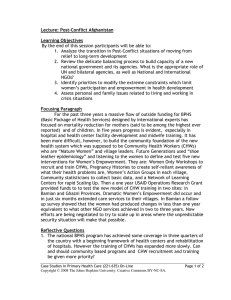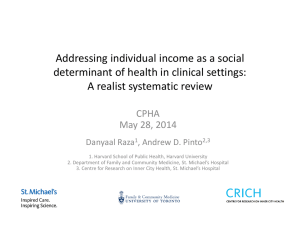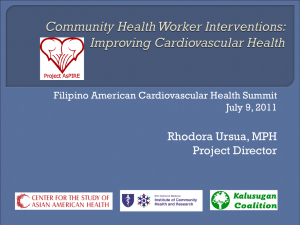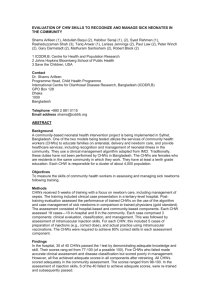The Role of Primary Care Practices in Improving Community Health ORPRN Convocation: 3/10-12/16
advertisement
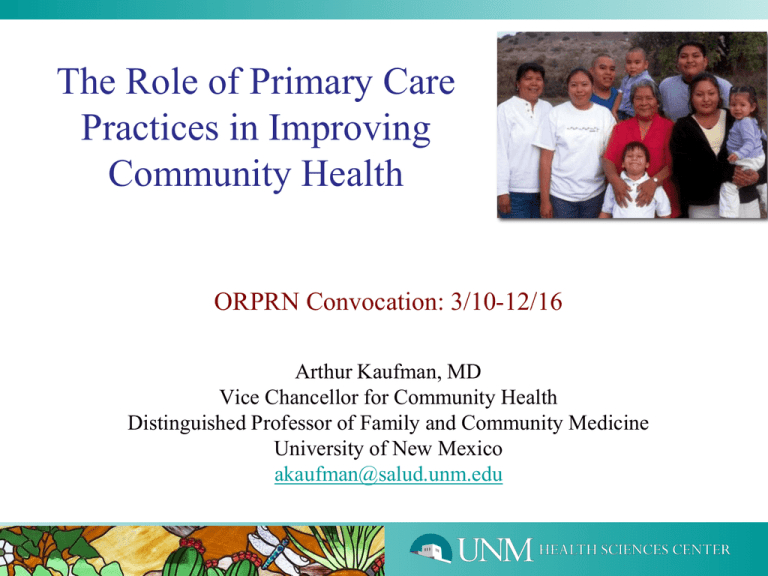
The Role of Primary Care
Practices in Improving
Community Health
ORPRN Convocation: 3/10-12/16
Arthur Kaufman, MD
Vice Chancellor for Community Health
Distinguished Professor of Family and Community Medicine
University of New Mexico
akaufman@salud.unm.edu
New Institutional Vision Statement
“The University of New Mexico Health Sciences
Center will work with community partners to
help New Mexico make more progress in health
and health equity than any other state by 2020.”
Comments from a Sampling of
Community Health Leaders
• You’re known as the “University of ABQ,”
• “You’re only present while grant funds last”
• “Build upon local wisdom, organizations, programs”
• “You need to commit to long term partnerships”
• “Have full-time presence in all communities like NMSU”
Quality Care is Not Enough
ex. Diabetes in Native Americans
• Recommended Preventive Services:
- Native Americans have best rates
• Deaths from Diabetes:
- Native Americans have highest rates
New Mexico Dept of Health 2010 Report on Ethnic
Disparities in Health
What are the Social
Determinants?
•
•
•
•
Income
Education
Nutrition
Housing
•
•
•
•
Transportation
Safety
Social Inclusion
Built Environment
5
The Social Health of the Fifty States:
Where is New Mexico?
This combines in a
single measure each
states’ performance on
16 social indicators
representing different
stages of life (ex. Child
poverty, teen drug use,
unemployment, suicide
among elderly, food
stamp coverage)
Source: Institute for Public Health
Addressing Social Determinants to Affect
Health Risks and Conditions
• Graduating from high school can save as many
lives as quitting smoking!
• 16% CV deaths among women, 9% among men
attributable to lack of high school degree
Krueger PM, Tran MK, Hummer RA, Chang VW (2015) Mortality
Attributable to Low Levels of Education in the United States. PLoS ONE
10(7):e0131809. doi:10.1371/journal.pone.o131809
7
Social Determinants have Bigger Impact
on Health than Health System:
• WHO Report on SDOH (Marmot)
• Amer. Assoc of Acad. Health Ctrs—SDOH
now their major focus
• Institute of Medicine—Completing a major
report on SDOH
• NM: State Improvement Model (SIM)
design emphasizes SDOH
8
Access and Ethnicity
• Population is becoming more ethnically diverse
• But U.S. medical students from more upper
income families
• Impact of ethnicity on access:
Health Workforce: A Public
Health, Economic Impact
• PCPs/100,000 population: a recognized
health metric
• 1 Physician in Rural Community
a) hires ~18 people directly, indirectly
b) generates ~ $1 million in business
annually
10
FM resident Outcomes, Plans
• 76 Residents, half in
ABQ, half in rural NM
• 25% of ABQ grads
work in rural NM
• 70% of rural NM grads
for in rural NM
State Medicaid GME $ (not
HRSA’s) to Train Prim Care Res
in FQHCs…Exceeding the “Cap”
• NM Legis + State Medicaid agreed to fund
primary care residency expansion
• $ to FQHC for added scope of serviceexpansion, new residency, rotations
• Amt of $ approx. $150,000/res/yr
Kaufman, Alfero Health Affairs Blog 7/31/15
12
New Health Workforce Members
• Health Extension Agents
• Community Health Workers
a) Social determinants their priority
b) Community is their base
13
Establish Health Extension Rural Offices
•
•
•
Place full-time agents in rural communities
across the state
Link community health priorities with UNM
resources
Monitor effectiveness of university programs
in addressing community health needs
Kaufman, A, et al: Health Extension in New Mexico: An Academic Health Center and the
Social Determinants of Disease. The Annals of Family Medicine, Jan. 2010, vol. 8 No. 1.
Map of HEROs and their regions
Helen Tso,
Shiprock
Charlene Poola,
Albuquerque
Juliana Anastasoff,
Taos
Components of HERO Hub
Elaine Luna,
Las Vegas
Local Higher
Educa on
Ins tu ons
Francisco Ronquillo,
Albuquerque
Community
Hospitals &
Health Centers
Civic
Organiza ons
UNM HSC
Programs &
Resources
Alisha Herrick,
Silver City
Marnie Nixon,
Las Cruces
Evelyn
Rising,
Hobbs
Area Health
Educa on
Centers
County
Health
Councils
15
McKinley County – Crownpoint
Youth/Pipeline Development into Health Professions
•
•
•
“Grow our own”
“Health Summit” – Eastern Navajo
Mid-Schoolers
Future mentoring
How We’re Changing Research:
2007 Top Health Priorities from 31 County
and 6 Tribal Councils
(compared with UNM HSC research priorities)
County Health Councils’
Priorities (in order)
–
–
–
–
–
–
Substance Abuse
Teen Pregnancy
Obesity
Access to Care
Violence
Diabetes
UNM HSC Research Priorities
(“Signature Programs”)
–
–
–
–
Cancer
Cardiovascular and
Metabolic Diseases
Brain and Behavior
Infectious Disease and
Immunity
HEROs’ Roles in CTSC
Scholarship
• HEROs help engage community participation in
CTSC research
• HEROs “shop” community questions/needs to CTSC
researchers
• HEROs develop local programs, find CTSC
researchers to study them
• HEROs/CTSC researchers build local capacity
• HERO program becomes focus of scholarship itself
18
19
CHW: New Member of the
Health Team
CHW is someone who is a:
• Frontline Public Health Worker
• Trusted member of community
• Understand community served
• Culturally competent service delivery
• Increase health knowledge
• Social Support and advocacy
20
4 in 5 Physicians Surveyed
• Patients’ social needs as important as
medical conditions
• Not confident in their capacity to address
social needs
• Unmet social needs leading to worse health
for all, not just those with low income
Health Care’s Blind Side: The Overlooked Connection between Social Needs and Good Health.” Online Report. Princeton
NJ: Robt Wood Johnson Foundation. December, 2011
21
Objections to Primary Care Practices
addressing Social Determinants
• Too busy (with EMR, ICD-10, Adapting to
PCMH, etc) to take anything else on
• Addressing them takes too much time
• Social Determinants not the expertise of
Primary Care practitioners
• No reimbursement for addressing them
22
Social Determinants
Name ________________________________________ Age _______
Address ______________________________________ Date _______
Referral to Community Health Worker for:
Food Assistance
Employment Assistance
Housing Assistance
Education Assistance
Utilities Assistance
Substance Abuse Assistance
Transportation Assistance
Safety Assistance
Daycare Assistance
Domestic Violence Assistance
Legal Assistance
Other
___________________________________________________________________
Provider Signature
Well Rx Survey Responses (N = 3,048)
24
Addressing “I’m too busy…takes too
much time”
If clinics don’t address SDOH
a) increased demand on clinician’s time
b) decreased adherence to treatment plans
c) increased preventable, clinic visits
d) increased cost of care (ex. Preventable
tests, unnecessary ED visits)
25
Addressing “Not the Expertise of
Primary Care Providers”
• The primary team needs to be bigger
• The primary team needs to think outside the
PCMH/clinic walls to a “CommunityCentered Health Home” or “Health
Commons”
• Health Extension Agents (HEROs) and
Community Health Workers (CHWs)
critical, new team members
26
Addressing “There’s no
reimbursement for addressing
SDOH”
• CHWs addressing SDOH can now be
funded by Medicaid Managed Care
• CHWs work with discharged patients can
reduce financial penalties by reducing 30day re-admissions
• ICD-10 “z codes”—can now bill for SDOH
27
What are these “Z codes?”
• Each SDOH has an ICD-10 code ex.
- Lack of Food – Z59.4
- Inadequate Housing – Z59.1
- Lack of Education – Z55.9
- Lack of Transporation – Z59.8
• A Med Assistant can enter them in EHR
28
CHWs and Medicaid Managed Care
Health insurers contract with Univ to hire,
train CHWs
CHWs help “manage” high users in comm
Health insurers ROI ~4:1
Program all over New Mexico, in10 states
Maintain current contrac ng for Level 3 members, through MCO referral process: $321 PMPM
Popula on management for Level 2 & 1 members: ~$5.75 PMPM
(base popula on of 5,000 members)
30
CHWs for All Medicaid Patients:
A Pilot
• NM Medicaid partnering with UNM to Plan
Statewide Role for CHWs in all 3 Levels
• All Medicaid MCOs fund CHWs- Level III
• Blue Cross and Molina will also fund CHW
care for Levels I (community population
prevention), II (chronic dis. management)
• 10,000 in urban and rural pilot @ $5.75
pmpm
31
32
Importance of CHWs for our
Learners
ACGME: requires residency programs to
address health disparities via QI activities
Resident experiences with CHWs
•
•
•
•
Enhanced inter-prof. teamwork
Enhanced cultural proficiency
Enhanced cost-conscious care
Promoted advocacy for patients and communities
McCalmont K, Norris J, Garzon A et al. Community Health Workers and Family Medicine Resident
Education: Addressing the Social Determinants of Health. Family Medicine, 2016. (in press)
33
University Hospital Response
• Now all primary care clinics assigned 2 or 3
CHWs
• Medical Assistants ask ALL patients SDOH
screening questions
• Those Patients screening positive for at
least one referred to CHW that day
• Approximately half agree to see CHW then,
half the rest agree to see the CHW later
34
Health Measures for Lea County: Red Flags
Example of Determinant and Outcome
Tracking in State
To
move
up 3
states
2010
Value
2010
Rank
No 1
State
('11)
Primary Care Physicians
(Number per 100,000
population)
113.6
27
191.9
116
About 50 more primary care
physicians
High School Graduation
(Percent of incoming 9th
graders)
59.1
48
89.6
64.1
About 1,500 more students
graduating
Determinants/Outcomes
What this means for us
36
States Developing Health
Extension or Community Health
Worker Programs
HEROs - 16 states
CHW - 10 states
Sustainable Funding Sources
•
•
•
•
•
•
•
•
Academic Health Center
NIH- CTSC
CMS- SIM
CMS- Accountable Health Communities
Fed Agencies—ex. CDC REACH, HRSA
Local Government- Counties
Local Hospitals
*Managed Care/ACOs capitation, Medicaid
38
